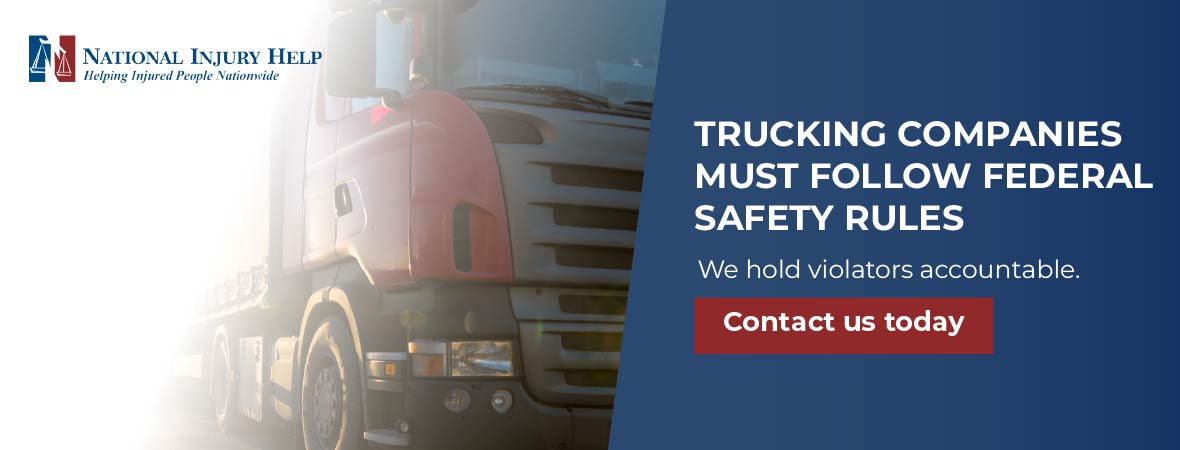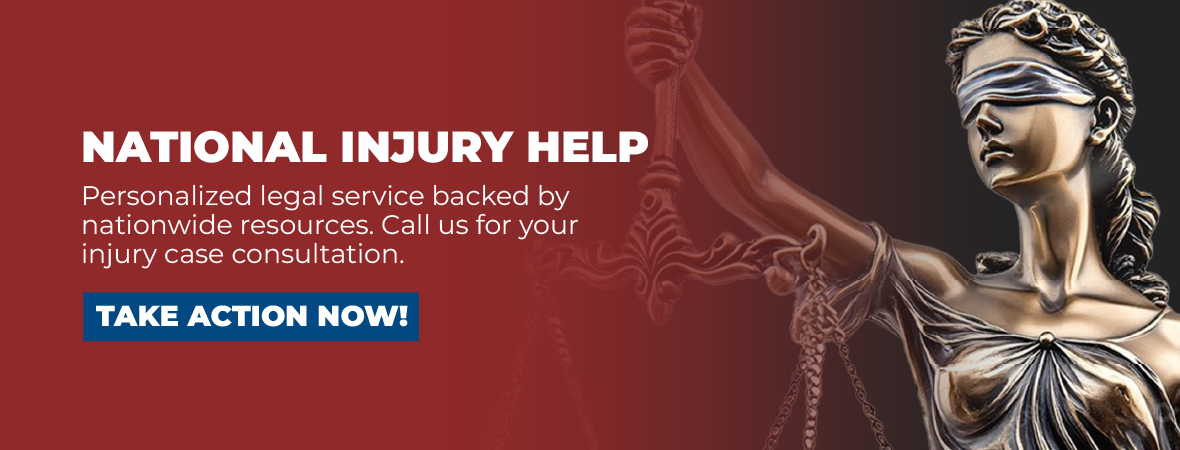Truck drivers and companies must follow strict federal safety rules. When they ignore these regulations, accidents happen and lives are put at risk. If you were injured in a truck crash, contact National Injury Help today. We are here to fight for your rights.
Big trucks are a vital part of daily life in the U.S. They deliver food to stores, medicine to hospitals, and supplies to factories across the country. But with that essential work comes serious responsibility, especially when a fully loaded truck can weigh up to 80,000 pounds, or about 20 times more than the average car. When something goes wrong at highway speeds, the outcome can be devastating.
That’s why federal safety rules are in place: to prevent accidents and protect everyone on the road. And when a crash does happen, those same rules can help uncover what went wrong and who’s responsible.
Who Regulates Commercial Trucking in the U.S.?
The Federal Motor Carrier Safety Administration (FMCSA) is the main federal watchdog for trucks and buses. It was created in 2000 and does the following:
- The agency writes regulations (called the Federal Motor Carrier Safety Regulations, or FMCSRs).
- Gives safety advice to carriers.
- Partners with state troopers for roadside inspections.
- It can shut a truck down on the spot if a serious violation is found.
Even though the agency is “federal,” state police officers enforce the same code during most traffic stops and weigh-station checks.
Which Vehicles Must Follow Federal Rules?
A truck, bus, or van is usually covered if it:
- Has a Gross Vehicle Weight Rating (GVWR) of 10,001 pounds or more and crosses state lines for business, or
- Hauls hazardous materials that need placards (even smaller trucks must comply when carrying dangerous cargo), or
- Carries nine or more people, including the driver, for pay (think airport shuttles and tour buses).
Local delivery fleets that never leave one state often answer to state rules that closely copy the federal code. In practice, most midsize and large carriers run at least an occasional interstate load, so they follow the FMCSRs every day.
Key Federal Trucking Regulations
The rulebook is hundreds of pages long, but four chapters land in courtrooms more than any others: Hours of Service, Driver Qualification, Vehicle Maintenance, and Cargo Control.
The federal trucking rulebook is massive, but a few key areas come up in accident cases more than any others. These include Hours of Service, Driver Qualification, Vehicle Maintenance, and Cargo Control. Let’s start by breaking down the Hours of Service rules—these are designed to prevent driver fatigue, which is one of the most common and dangerous causes of truck crashes.
Hours of Service (HOS) Limits
The goal of these rules is to make sure truck drivers get enough rest and avoid driving while overly tired. Here are the basics everyone should understand:
Truck drivers are allowed to drive for up to 11 hours in one stretch, but those 11 hours must fall within a 14-hour window that starts the moment the driver begins any kind of work for the day. For example, if a driver begins loading cargo or filling out paperwork at 6 a.m., that starts the clock. Even if they take breaks during the day, all driving must stop by 8 p.m.
After driving for eight consecutive hours, drivers must take a break of at least 30 minutes before continuing. So if a driver is behind the wheel from 8 a.m. to noon, they need to stop and rest before hitting the road again.
There’s also a weekly cap. Drivers can’t be on duty more than 60 hours in a 7-day workweek or 70 hours in an 8-day workweek. The rule that applies depends on how often the trucking company operates.
To allow for some flexibility, drivers can split their rest time into two segments. One of those segments must be at least 7 or 8 hours long and must be spent in the sleeper berth of the truck. The second segment can be shorter, but both parts together help reset the driver’s work clock.
Finally, most long-haul truckers are required to use an electronic logging device (ELD). This device connects to the truck’s engine and automatically records driving hours. Paper logs are only allowed in limited cases, such as certain farm or local hauls within a 150-mile radius.
These rules exist for a reason. When drivers push beyond these limits, the risk of serious accidents goes up sharply. And when trucking companies ignore them, they can be held legally responsible for the consequences.
Driver-Qualification Standards
Driving a 40-ton rig safely takes skill and good health.
- Commercial Driver’s License (CDL): Extra knowledge tests cover air brakes, tankers, doubles, and more.
- Medical Certificate: An FMCSA-approved examiner checks eyesight, hearing, heart health, and more every two years (or sooner if a condition exists).
- Drug & Alcohol Clearinghouse: Employers must review a driver’s drug history before hiring and run annual checks after that.
- Random Testing: Carriers test a set percentage of drivers each year without warning. The legal blood-alcohol limit is 0.04 BAC, half the passenger-car standard.
Truck Maintenance and Inspection
Part 396 of the FMCSRs says every carrier must have a “systematic inspection, repair, and maintenance program.” Records must prove the program is real, not just words on paper. Drivers must inspect the truck and trailer before and after each shift and record defects in a written report kept for 90 days.
Additionally, there should be an annual inspection where a certified mechanic signs off that brakes, lights, steering, frame, and tires all meet minimum standards. Proof travels with the vehicle (often a sticker).
Weight Limits and Cargo Securement
There are also some weight limits and rules guiding how to properly secure cargo while driving a truck.
- Gross weight on most interstate highways: 80,000 pounds. Heavier loads need a special permit and often face route restrictions.
- Axle limits: 20,000 pounds on one axle and 34,000 on a tandem.
- Cargo securement rules demand that loads stay put under 0.8 g forward force and 0.5 g in any sideways or backward motion. Straps, chains, and anchor points have rated working-load limits.
- Hazardous materials (hazmat): Extra placards, route planning, and emergency info are mandatory. Tankers hauling fuel, chemicals, or liquefied gas must meet even stricter construction and inspection rules.
Common Ways Trucking Companies Break the Rules
Despite clear regulations, tight schedules, and profit pressure, some carriers bend, break, or have broken the law. Here are the trouble spots investigators see again and again:
- HOS Cheats – Drivers “go off duty” while fueling or waiting at docks, or they edit ELD files after the trip.
- Drug & Alcohol Violations – A positive test or test refusal should sideline a driver, yet small outfits sometimes let offenders back behind the wheel too soon.
- Unqualified Drivers – Missing road-test documents, expired medical cards, or suspended CDLs hide in dusty filing cabinets until a crash exposes them.
- Maintenance Shortcuts – Worn brake linings, cracked rims, and bald steer tires are leading causes of out-of-service orders during yearly North American inspections.
- Overweight or Shifting Loads – Too much weight strains tires and brakes; loose steel coils or heavy pipes can roll a trailer or spear through a cab during hard stops.
How Violations Can Influence an Injury Lawsuit
FMCSA violations can significantly influence your case. Here’s how:
Negligence Per Se
If a truck driver (or carrier) breaks a safety law meant to protect the public, and that rule break leads to a crash, most states treat the violation itself as proof of negligence.
The injured person still has to show that the violation caused the harm, but half the battle, proving the carrier acted unreasonably, is already won.
Evidence That Makes the Difference
Lawyers who focus on truck cases quickly send a spoliation letter telling the carrier to preserve:
- Raw ELD data, driver edits, and back-office audit trails.
- Dash-camera or cabin video.
- Vehicle “ECM” or “black-box” speed and brake data.
- Maintenance logs going back months or years.
- Drug-test results and personnel files.
- Weight tickets and bills of lading.
Experts then match those records to skid marks, crush damage, and medical findings to explain exactly how the crash unfolded.
More Than One Defendant
A truck case often names several parties:
- Driver: For mistakes behind the wheel.
- Motor carrier: For poor hiring, training, or supervision.
- Maintenance contractor: If a repair shop left the brakes unsafe.
- Shipper, loader, or broker: If the cargo was packed badly or delivery deadlines were impossible.
Spreading liability ensures the injured family is fully compensated, even if one party lacks deep pockets or strong insurance.
What to Do After a Suspected FMCSA Violation
Follow these steps if you’ve been injured in a truck accident:
- Get Medical Care First. Health comes before paperwork.
- Talk to an Experienced Truck-Crash Attorney. Truck wrecks are different from fender-benders. Look for a lawyer who advertises real experience with FMCSA rules and has handled multi-defendant cases.
- Move Fast. Many ELD systems overwrite data in 7–30 days. Early legal action secures electronic files before they disappear.
- Collect Your Own Evidence. Photos of the scene, vehicle damage, skid marks, and your injuries can fill in the gaps later.
- Keep a Journal. Pain levels, doctor visits, and missed workdays documented in real time help justify damages when it’s settlement time.
- Request Official Reports. Police crash reports, weigh-station citations, and, in serious cases, National Transportation Safety Board (NTSB) documents provide a neutral baseline.
Contact a Truck Accident Lawyer
Federal commercial truck laws exist for one reason: to keep people safe on the road. When a trucking company ignores those rules and someone gets hurt, it’s not just a mistake; it’s a violation of trust and responsibility. That’s where we come in.
At National Injury Help, we don’t just understand the law; we know how to apply it to real-life cases. Our team knows the ins and outs of trucking regulations and how to spot when a company has cut corners. We move quickly to investigate, gather proof, and hold the right people accountable. Whether it’s skipped inspections, overworked drivers, or faulty equipment, we know how to build a strong case and fight for the compensation you deserve.
You don’t have to face this alone. Your consultation is 100% free, and you pay us nothing unless we win for you. Call us at 1 (800) 214-1010 today. We’ll take on the legal burden so you can focus on healing and getting your life back on track.








